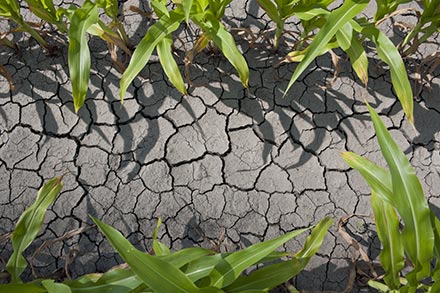Weather variability is one of the largest sources of risk in agricultural production (Figure 1). Congress has recognized the impact of weather variability on crop production and the resulting variability to farm income by implementing a special tax provision.

Internal Revenue Code (IRC) Section 451(f) provides that, under certain circumstances, crop producers reporting on the cash method of accounting may elect to include crop insurance and disaster payments in income of the tax year following the taxable year of crop destruction or damage. To qualify for this election, the taxpayer must establish that the income from the destroyed or damaged crop would have been included in income for a taxable year following the year of destruction or damage under his or her normal business practices.
Additionally, crop disaster program payments received from the federal government qualify for the IRC Section 451(f) election if a natural disaster prevented a farmer from planting crops, or it destroyed or damaged crops that had already been planted.
Proceeds received from revenue insurance policies may be the result of either yield loss due to physical damage, or to a decline in price from planting to harvest. For these policies, only the amount of the proceeds received because of damage or destruction, i.e., yield loss, can be deferred.
Proceeds received from weather insurance policies cannot be deferred if the payment is based on rainfall amounts and is not a result of physical damage to a crop.
Example
John Farmer operates a grain farm and uses the cash method of accounting. During 2024, John received the following amounts of insurance proceeds for the damage caused to his crops by a hailstorm on June 20: corn $25,000, soybeans $20,000 and wheat $5,000.
If John can establish that under normal business practices he would have reported a substantial amount of the income from the 2024 crops in a subsequent tax year, he may either report the insurance proceeds as 2024 income or elect to defer the $50,000 ($25,000 + $20,000 + $5,000) of insurance proceeds to 2025.
Observation
- Substantial portion of the income is considered to be more than 50%.
- To qualify for deferral, the insured must suffer an actual — not a contingent — loss.
- Because the insurance proceeds in the example are attributable to crops representing a single trade or business, John may elect to defer all or none of the insurance proceeds. He may not allocate the proceeds between the two years.
- Taxpayers receiving insurance proceeds in the tax year following the tax year of destruction or damage include the proceeds as income in the year of receipt without needing to make the IRC Section 451(f) election.
Making the election
To qualify for the deferral, a taxpayer must make an affirmative election of eligible payments under IRC Section 451(f). The U.S. Internal Revenue Service (IRS) has denied deferrals when insufficient information was included with the return to qualify as an affirmative election and details of the deferral were missing. For example, the mere disclosure that insurance proceeds are being deferred does not constitute an election under IRC Section 451(f).
To postpone reporting some or all crop insurance proceeds received in 2024, report the amount received on Schedule F, line 6a, but do not include it as a taxable amount on line 6b. Check the box on line 6c, and attach a statement to the tax return. The statement must include the following information:
- Taxpayer’s name and address
- Statement that the taxpayer is taking the election under 451(f) and Regulations section 1.451-6
- The specific crop or crops that were physically destroyed or damaged
- Statement that under normal business practice, the taxpayer would have included more than 50% of the income from some or all of the destroyed or damaged crops in gross income for a tax year following the year the crops were destroyed or damaged
- The cause of the physical destruction or damage, and the date or dates it occurred
- The total payments received from insurance companies, itemized for each specific crop, and the date each payment was received
- Name of each insurance company that issued the payments
The election may be made on an amended return. However, once the election is made, it is binding for the taxable year for which it is made unless the IRS consents to its revocation.
Revenue Protection policies
Revenue Protection (RP) policy payments are based on price, quantity and quality of the commodity produced. Only payments for destruction or damage are eligible for the IRC Section 451(f) deferral. Therefore, when making an election to postpone recognition of income, a farmer who receives compensation from an RP crop insurance policy must determine the portion of the indemnity payment that based on crop destruction or damage and not on reduced market prices.
Missouri tax law
The Revised Statutes of Missouri (RSMO) Section 143.121, No. 10, includes an income tax subtraction for payments received from a program that compensates agricultural producers who have suffered a loss due to a disaster or emergency. The subtraction can be claimed on the Missouri Individual Income Tax Return (Form MO-1040), Missouri Fiduciary Income Tax Return (Form MO-1041) and the Missouri Corporation Income Tax Return (Form MO-1120) for tax years beginning on or after Jan. 1, 2014.
Claims for agricultural disaster relief for proceeds from crop insurance must include a statement of the loss or disaster, to include the event and the county in which it occurred.
Resources
These free references are available for further investigation into this topic:
- IRS Publication 225, Farmer’s Tax Guide. A printed copy is available at most local MU Extension centers.
- IRS Publication 547, Casualties, Disasters and Thefts.